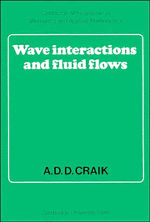Book contents
- Frontmatter
- Contents
- Preface
- 1 Introduction
- 2 Linear wave interactions
- 3 Introduction to nonlinear theory
- 4 Waves and mean flows
- 5 Three-wave resonance
- 6 Evolution of a nonlinear wave-train
- 7 Cubic three- and four-wave interactions
- 8 Strong interactions, local instabilities and turbulence: a postscript
- References
- Index
3 - Introduction to nonlinear theory
Published online by Cambridge University Press: 01 June 2011
- Frontmatter
- Contents
- Preface
- 1 Introduction
- 2 Linear wave interactions
- 3 Introduction to nonlinear theory
- 4 Waves and mean flows
- 5 Three-wave resonance
- 6 Evolution of a nonlinear wave-train
- 7 Cubic three- and four-wave interactions
- 8 Strong interactions, local instabilities and turbulence: a postscript
- References
- Index
Summary
Introduction to nonlinear theory
Introductory remarks
Nonlinear theories are of three more or less distinct kinds. In one, properties of arbitrarily-large disturbances are deduced directly from the full Navier–Stokes equations. Consideration of integral inequalities yields bounds on flow quantities, such as the energy of disturbances, which give stability criteria in the form of necessary or sufficient conditions for growth or decay with time. An admirable account of such theories is given by Joseph (1976). They have the advantage of supplying mathematically rigorous results while incorporating very few assumptions regarding the size or nature of the disturbances. Sometimes, these criteria correspond quite closely to observed stability boundaries. The bounds for onset of thermal (Bénard) instability and centrifugal (Rayleigh–Taylor) instability in concentric rotating cylinders are particularly notable successes. Often, however, the bounds are rather weak: this is especially so for shear-flow instabilities, where local details of the flow typically play an important rôle which cannot be (or, at least, has not been) incorporated into the global theory.
The second class of theories relies on the idea that linearized equations provide a satisfactory first approximation for those finite-amplitude disturbances which are, in some sense, sufficiently small. Successive approximations may then be developed by expansion in ascending powers of a characteristic dimensionless wave amplitude. These are known as weakly nonlinear theories, and they have proved successful in revealing many important physical processes.
- Type
- Chapter
- Information
- Wave Interactions and Fluid Flows , pp. 65 - 74Publisher: Cambridge University PressPrint publication year: 1986



